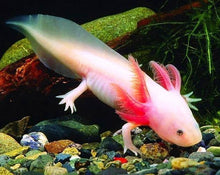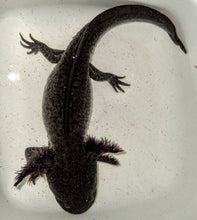Guaranteed Secured Checkout
Axolotls
The colours available are pink gold
Axololts are super interesting pets and they are easy to care for with little fuss. Just ensure that you have good filtration, clean water and that you feed them with the appropriate nutritionally benefical food.
Axolotls have a unique feature about them in tha, they can regenarete their limbs, as creapy as this may sound, they can actually do this. Axolotls can at times be canibalistic and eat their own.
Axolotls come from the Salamander family and are pretty much extinct in the wild. The only recorded population of axolotls are said to be from lake Xochimilco.
Axolotls live long when they are well cared for, with a life span of up to 15 years. The staff at Melbourne Tropical Fish absoloutley love these little critters and get quite excited when they lay eggs and breed in our tanks.
Axolotls should be kept in a stable aquatic environment.
They require the water temperature to be maintained between 14°C (they dont like warm temperaturres)
and 19°C. If it gets walm, place an ice pack in your aquarium to keep them comfortable if the weather gets too hot.-pH of 7.40-7.60
-Ensure you have a good filter system, but maintain relatively calm water flow, as heavy flow can stress axolotls out. External canister filters fitted with flow-spreading outlets (like a spray bar) will keep your water clean without upsetting its flow.
-Substrate is recommended to provide a place for good bacteria to live. Substrate should either be sand, plant substrate, or large river stones. Pebbles should NOT be used as many axolotls will ingest these smaller stones, leading to intestinal blockages and even death
-Axolotls are used to the low-lighting conditions found in their native Mexican habitats.
-Feed 2-3 times a day. Some food items that we recommend are:
Tubifex worms, bloodworms, shrimp, beef heart, insects,
feeder fish and balanced pelleted foods.
Whole foods such as worms, shrimp and insects are more balanced and therefore better for your
axolotl.
This is what you need to know if you want to keep axolotls
1. Tank Setup:
- Axolotls require a spacious aquarium with a minimum size of 20 gallons for a single axolotl and an additional 10 gallons for each additional axolotl. Dont put them in smaller tanks as this would not be good for them.
- Provide hiding spots with caves or plants, but ensure they won't harm your axolotl.
2. Water Conditions:
- Maintain a temperature between 60-68°F (15-20°C). Use a reliable aquarium heater or room cooler if necessary.
- Use a good quality water filter to keep the water clean and ensure proper circulation.
- Axolotls are sensitive to chlorine and chloramine, so use a water conditioner to dechlorinate tap water.
- Check water parameters regularly, aiming for pH levels between 6.5-7.5 and ammonia/nitrite levels at zero.
3. Feeding:
- Feed your axolotl 2-3 times a week. They are carnivores and primarily eat live or frozen food.
- Suitable options include bloodworms, brine shrimp, daphnia, and small earthworms.
- Avoid feeding them large prey as it can lead to choking or digestive issues.
4. Handling:
- Minimize handling your axolotl as their skin is sensitive and can easily become stressed or injured.
- When you do need to handle them, use wet hands to avoid damaging their skin's protective mucus layer.
5. Tank Mates:
- Axolotls are best kept alone or with other axolotls of a similar size and temperament. Avoid housing them with fish or aggressive tank mates.
6. Water Quality:
- Regularly test and maintain water quality, as poor water conditions can lead to stress and disease.
- Perform partial water changes of about 20% every week to keep ammonia and nitrite levels low.
7. Lighting:
- Axolotls are sensitive to bright light, so provide low-intensity lighting or keep the tank in a dimly lit room.
8. Health Care:
- Keep an eye out for signs of illness, such as loss of appetite, lethargy, or abnormal behavior.
- Quarantine new arrivals before introducing them to your main tank to prevent the spread of diseases.
9. Breeding:
- Breeding axolotls is a complex process that requires specific conditions and care. It's best left to experienced breeders.
10. Longevity:
- With proper care, axolotls can live up to 10-15 years or more, so be prepared for a long-term commitment.
In summary, axolotls are captivating and unique aquatic pets that require specific care to thrive. Providing them with a suitable tank setup, clean water, a balanced diet, and minimizing stressors will help ensure their health and longevity.
Axollotl assorted colours * stocks are limited



